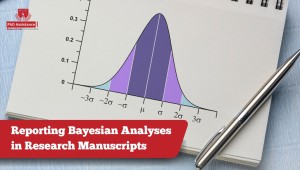Reporting Bayesian Analysis
Reporting Bayesian Analyses in Research Manuscripts
Reporting Bayesian Analyses

Recent Post
Introduction
1. Specify Prior Probabilities
2. Justify the Selection of Priors
3. Describe the Statistical Model
4. Detail the Analytical Techniques
6. Summarize the Posterior Distribution
7. Conduct Sensitivity Analysis
Summary Checklist for Reporting Bayesian Analyses
| Reporting Element | Required? |
| Priors specified and justified | Yes |
| Statistical model clearly described | Yes |
| Computational techniques explained | Yes |
| Software/tools identified | Yes |
| Posterior summaries with credibility intervals | Yes |
| Sensitivity to priors assessed | Recommended |
Conclusion
References
1. Cox, C., Bergmann, C., Fowler, E., Keren-Portnoy, T., Roepstorff, A., Bryant, G., & Fusaroli, R. (2023). A systematic review and Bayesian meta-analysis of the acoustic features of infant-directed speech. Nature Human Behaviour, 7(1), 114-133.
2. Frühwirth-Schnatter, S., Hosszejni, D., & Lopes, H. F. (2025). Sparse Bayesian Factor Analysis when the number of factors is unknown (with Discussion). Bayesian Analysis, 20(1), 213-344.
3. Goligher, E. C., Heath, A., & Harhay, M. O. (2024). Bayesian statistics for clinical research. The Lancet, 404(10457), 1067-1076.
4. Huth, K. B., de Ron, J., Goudriaan, A. E., Luigjes, J., Mohammadi, R., van Holst, R. J., … & Marsman, M. (2023). Bayesian analysis of cross-sectional networks: A tutorial in R and JASP. Advances in Methods and Practices in Psychological Science, 6(4), 25152459231193334.
5. Jiang, J. L., Ecker, C., & Rezzolla, L. (2023). Bayesian analysis of neutron-star properties with parameterized equations of state: The role of the likelihood functions. The Astrophysical Journal, 949(1), 11.
6. Liu, Y., Béliveau, A., Wei, Y., Chen, M. Y., Record-Lemon, R., Kuo, P. L., … & Chen, G. (2023). A gentle introduction to Bayesian network meta-analysis using an automated R package. Multivariate Behavioral Research, 58(4), 706-722.
7. Muehlemann, N., Zhou, T., Mukherjee, R., Hossain, M. I., Roychoudhury, S., & Russek-Cohen, E. (2023). A tutorial on modern Bayesian methods in clinical trials. Therapeutic Innovation & Regulatory Science, 57(3), 402-416.
8. Pfadt, J. M., Bergh, D. V. D., Sijtsma, K., & Wagenmakers, E. J. (2023). A tutorial on Bayesian single-test reliability analysis with JASP. Behavior Research Methods, 55(3), 1069-1078.
9. Reddin, C., Ferguson, J., Murphy, R., Clarke, A., Judge, C., Griffith, V., … & O’Donnell, M. J. (2023). Global mean potassium intake: a systematic review and Bayesian meta-analysis. European Journal of Nutrition, 62(5), 2027-2037.
10. Sun, X., Hu, Y., Qin, Y., & Zhang, Y. (2024). Risk assessment of unmanned aerial vehicle accidents based on data-driven Bayesian networks. Reliability Engineering & System Safety, 248, 110185.

